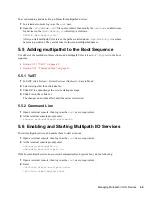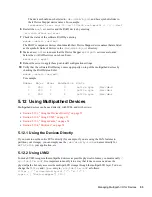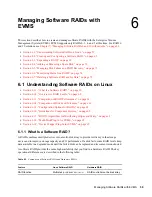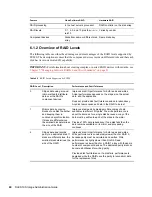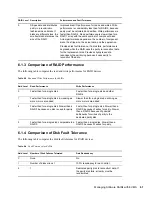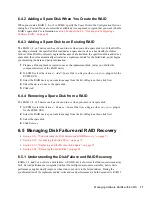
60
SLES 10 Storage Administration Guide
no
vd
ocx
(e
n)
6 Ap
ril 20
07
6.1.2 Overview of RAID Levels
The following table describes the advantages and disadvantages of the RAID levels supported by
EVMS. The description assumes that the component devices reside on different disks and that each
disk has its own dedicated I/O capability.
IMPORTANT:
For information about creating complex or nested RAID devices with mdadm, see
Chapter 7, “Managing Software RAIDs 6 and 10 with mdadm,” on page 81
.
Table 6-2
RAID Levels Supported by EVMS
RAID processing
In the host server’s processor
RAID controller on the disk array
RAID levels
0, 1, 4, 5, and 10 plus the
mdadm
raid10
Varies by vendor
Component devices
Disks from same or different disk
array
Same disk array
RAID Level Description
Performance and Fault Tolerance
0
Stripes data using a round-
robin method to distribute
data over the RAID’s
component devices.
Improves disk I/O performance for both reads and writes.
Actual performance depends on the stripe size, the actual
data, and the application.
Does not provide disk fault tolerance and data redundancy.
Any disk failure causes all data in the RAID to be lost.
1
Mirrors data by copying
blocks of one disk to another
and keeping them in
continuous synchronization.
If disks are different sizes,
the smallest disk determines
the size of the RAID.
Improves disk reads by making multiple copies of data
available via different I/O paths. The write performance is
about the same as for a single disk because a copy of the
data must be written to each of the disks in the mirror.
Provides 100% data redundancy. If one disk fails then the
data remains available on its mirror, and processing
continues.
4
Stripes data and records
parity to a dedicated disk. If
disks are different sizes, the
smallest disk determines the
size of the RAID.
Improves disk I/O performance for both reads and writes.
Write performance is considerably slower than for RAID 0,
because parity must be calculated and written. Write
performance is slightly slower than RAID 5. Read
performance is slower than for a RAID 1 array with the same
number of component devices. The dedicated parity disk can
become a bottleneck for writing parity.
Provides disk fault tolerance. If a disk fails, performance is
degraded while the RAID uses the parity to reconstruct data
for the replacement disk.
Feature
Linux Software RAID
Hardware RAID
Summary of Contents for LINUX ENTERPRISE SERVER 10 - STORAGE ADMINISTRATION GUIDE 7-2007
Page 4: ...novdocx en 6 April 2007...
Page 30: ...30 SLES 10 Storage Administration Guide novdocx en 6 April 2007...
Page 42: ...42 SLES 10 Storage Administration Guide novdocx en 6 April 2007...
Page 58: ...58 SLES 10 Storage Administration Guide novdocx en 6 April 2007...
Page 90: ...90 SLES 10 Storage Administration Guide novdocx en 6 April 2007...
Page 100: ...100 SLES 10 Storage Administration Guide novdocx en 6 April 2007...
Page 106: ...106 SLES 10 Storage Administration Guide novdocx en 6 April 2007...




